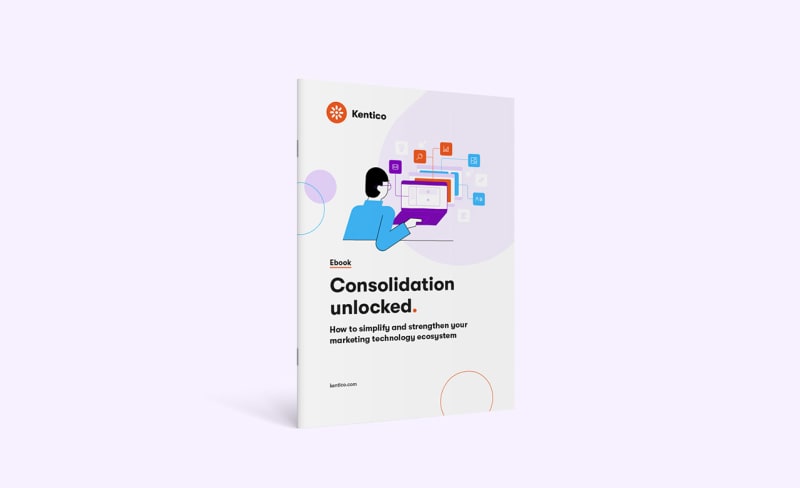Managing content across multiple sites and microsites can be a challenge for marketers, especially as the marketing tech stack becomes increasingly complex. We're exploring different approaches to microsite management, highlighting that some methods can help reduce complexity while others may lead to an uncontrolled and messy environment. Discover tips for a strategic approach, so your team doesn't need to resort to insufficient solutions that result in disconnected ecosystems.
Managing microsites
According to the State of Headless 2023 Research, conducted by Kentico among 500 marketing professionals, 48% of respondents use three or more microsites to achieve their marketing goals. Interviews with industry analysts reveal that a significant number of companies manage between 10 and 50 microsites.
The research also indicates that 54% of marketers have three or more primary websites, and 31% use three or more Content Management Systems (CMS) or Digital Experience Platforms (DXP).
In summary, many marketing teams multiple websites and dozens of microsites, often conducting multi-site management across various Content Management Systems. Additionally, 98% of them use some form of email marketing tool, which serves as another channel for content distribution and customer engagement.
Three approaches to microsite management
It is evident that most marketing teams in rapidly growing companies lack a strategic approach to managing the future growth of their sites or content management systems, which is essential for supporting and controlling such expansion. Often, they resort to "quick and dirty" solutions to launch campaign microsites in the shortest possible time, with minimal effort, and within a reasonable budget. Frequently, each microsite operates on its own instance of a CMS, sometimes even using different CMS brands. Often, teams are unaware of the technologies used by other teams within the company. This results in complex and disconnected ecosystems where content, visitor data, and analytics are not synchronized and remain siloed. Synchronization of visitor data with CRM, CDP, or other systems must be done separately for each site if it is done at all.
Generally, there are a few scenarios for multi-site management and channels:
Microsites and websites managed in multiple CMS solutions by different vendors
This often occurs when teams releasing microsites are unaware of each other’s activities or are under pressure to launch quickly, leading them to bypass consultation with other teams in the organization. This approach results in a messy and complex ecosystem that can become unmanageable over time. Additionally, content editors and administrators may need to learn new systems if they are expected to manage content across multiple sites.
All microsites managed in a CMS solution by one vendor
Many CMS systems (both open-source and commercial) do not support the management of multiple websites from a single CMS instance, leading to sites running on separate stand-alone instances. If there are plugins or add-ons, such as those for digital marketing, they must be installed independently for each instance. Content, visitor contacts, and analytics are not synced between site instances. Each system requires a separate sign-in, complicating the admin experience and increasing security risks. Keeping each instance updated with the latest security patches is also challenging. Moreover, it becomes difficult to track which content is managed by which CMS instance and which team as the number of microsites grows.
Managing all sites within a single-vendor solution using a single license
This scenario is more convenient for companies using multiple websites and microsites. Some Content Management Systems (CMS) and Digital Experience Platforms (DXP) offer flexible licensing that supports multiple sites and microsites, and upgrades if needed, eliminating the need to purchase extra licenses. With such systems, content governance is more effective as all content for sites and microsites can be managed from one place. Content can be created once and reused across multiple sites. You can potentially view customer analytics, cross-site customer journeys, and insights in a single dashboard. All platform capabilities can be utilized across any site or microsite. Thanks to a single instance and license, system maintenance, license management, and procurement are easier to handle. A single sign-in and centralized security updates significantly reduce security risks, making it easier for all the users of the platform.

SEO considerations for microsites
Generally, the primary purpose of microsites isn't SEO (search engine optimization), and their effectiveness in supporting SEO may be questionable. Let's have a look.
Microsites allow you to focus your content on niche, highly relevant keywords with good SERP ranking potential. However, it might be wiser to concentrate your efforts on keeping such content on a page within your main website to bolster the authority of the main domain. The risk—or rather, the missed opportunity—is that microsites can ultimately dilute your main domain's authority.
Some agencies and articles recommend creating microsites or small stand-alone sites to link back to your main website as a link-building strategy to boost your main page authority. The reality is that this strategy is unlikely to work, as microsites typically have very low domain authority initially. It would take a long time, considerable effort, and a lot of luck for a microsite to gain enough authority to significantly support your main website domain.
Microsites are excellent marketing tools, but their primary purpose shouldn’t be to support your SEO initiatives.
Microsite management consolidation
As explained above, the marketing tech stack often grows organically and uncontrollably to the point where it becomes cluttered, distributed, and overly complex. This complexity arises not only from managing websites and microsites across multiple CMS instances but also from the use of other marketing tools within the technology stack, such as email marketing, marketing automation, personalization, customer data management, and more. As a result, marketers find it increasingly challenging to use these technologies effectively due to their complexity.
As noted in the Gartner® 2023 Martech Survey: Utilization Plunges and Generative AI Anticipation Rises report, “Martech leaders report that the utilization of their organization’s overall martech stack’s capability is just 33% on average, marking a second consecutive year of decline. Efforts to raise utilization are obstructed by poor governance, stack complexity and sprawl, and talent challenges, which indicate teams struggle to follow through on ambitions to adopt their vast and costly martech portfolios.”1
The same issues apply to site management. It is nearly impossible to efficiently manage a corporate website, multiple main websites, and numerous microsites across different CMSs. The management of such a large number of web assets can be streamlined by consolidating your content management platforms into a single management tool. This consolidation can significantly help marketing teams regain control over the efficiency of their content marketing efforts.
Multi-site management with Kentico
With Xperience by Kentico, you can consolidate the content management of websites, microsites, emails, and headless channels within a single platform and a unified content repository. You can comfortably manage content for all channels, reuse it across those channels, and make content changes from one central location. In the same way, you can also share page templates, visual components, and other assets from the main website to your microsites. Kentico also provides usage tracking across channels, giving you actionable insights into how your customers engage with your content.
This consolidated approach helps you maintain control over your content, even if you manage dozens of microsites and multiple main sites. With flexible licensing options, you can grow without being limited by the number of sites, microsites, or email channels. There’s no need to purchase additional licenses or launch sites using another open-source CMS.
Kentico is a digital experience platform, meaning it provides a content management system along with digital marketing capabilities such as email marketing, marketing automation, personalization, contact data management, and many others. These capabilities provide digital transformation strategies for your websites and maximize the effectiveness of your digital marketing efforts.
Download our free ebook, Consolidation unlocked, to get more information about how consolidation can help you get control of your content and strengthen your martech ecosystem.
1 Gartner, 2023 Martech Survey: Utilization Plunges and Generative AI Anticipation Rises, Benjamin Bloom, Audrey Brosnan, 18 August 2023 GARTNER is a registered trademark and service mark of Gartner, Inc. and/or its affiliates in the U.S. and internationally and is used herein with permission. All rights reserved.


